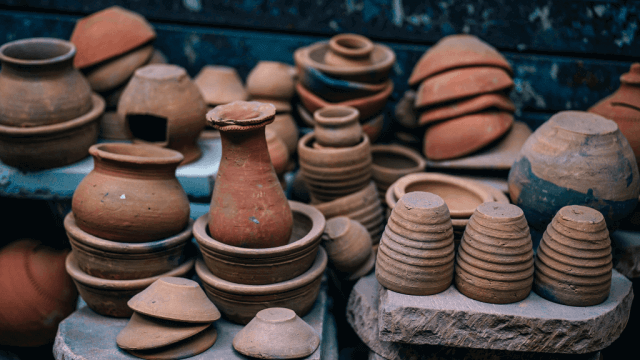The cost of pottery studio space varies depending on factors like location, size, and amenities.
Generally, expect to pay between $100 to $800 monthly for a shared space or $200 to $3,000 monthly for a private studio.
The pricing may change based on additional costs like utilities, maintenance, and equipment.
Factors Affecting Pottery Studio Space Costs
Understanding the factors influencing pottery studio space costs will help you find the right space for your needs and budget.
The following factors can impact the cost of renting a pottery studio space:
Location
The location of the pottery studio significantly affects the rent you pay.
Studio spaces in larger cities and high-demand areas tend to be more expensive than those in rural or less populated regions.
Size
The size of the pottery studio plays a crucial role in determining the rental cost.
A larger space will generally cost more, while smaller spaces may be more affordable.
Amenities
Some pottery studios come equipped with amenities like kilns, pottery wheels, and other equipment.
These additional features can increase the price of the studio space.
However, they can save you money in the long run, as you won’t need to purchase or maintain these items separately.
Shared Pottery Studio Spaces
Shared pottery studio spaces can be a cost-effective option for potters working with a limited budget or those who do not require a dedicated workspace.
These spaces allow multiple artists to work together, sharing equipment and costs.
Generally, expect to pay between $100 to $800 per month for a shared pottery studio space.
Benefits of Shared Spaces
- Lower rent and pottery costs
- Access to a wider range of equipment
- Opportunities for collaboration and learning from fellow artists
Considerations for Shared Spaces
- Potential scheduling conflicts with other artists
- Limited storage for personal supplies
- Possible distractions from others working in the space
Private Pottery Studio Spaces
Private pottery studio spaces allow for a dedicated workspace tailored to your needs.
The cost of private studio spaces typically ranges from $200 to $3,000 per month, depending on factors like location, size, and amenities.
Benefits of Private Spaces
- Control over workspace and equipment
- Increased privacy and focus
- Flexible scheduling and storage options
Considerations for Private Spaces
- Higher rental and pottery costs
- Responsibility for equipment maintenance and utilities
- Potential isolation from the ceramics community
Finding the Right Pottery Studio Space for You
When considering pottery studio options, it’s essential to balance cost, practicality, and your personal preferences.
Here are some steps to help you find the right pottery studio space:
Determine Your Budget
Before starting your search, assess your finances, and determine how much you can comfortably afford to spend on rent and pottery costs.
This will help you narrow down the available options.
Make a List of Requirements
Create a list of your specific needs, such as equipment, storage, ventilation, and accessibility.
This will help you identify studios that meet your requirements and save you time during your search.
Research and Compare Options
Explore various studio spaces in your desired location, both shared and private.
Don’t hesitate to ask about any extra costs, such as utilities and maintenance.
Compare available options to find the one that provides the best value for your needs.
Visit Potential Studio Spaces
Before signing a lease, visit your preferred studio spaces to ensure that everything meets your expectations.
Take note of the overall condition, existing equipment, and atmosphere, and ask any questions you may have.
Alternative Pottery Studio Solutions
If renting a dedicated pottery studio space is outside of your budget or not a suitable option for your needs, there are alternative solutions you can consider:
At-Home Pottery Studio
Transforming a spare room or garage into a pottery studio can be a cost-effective option.
However, consider the ventilation, equipment, and potential disruption to your living space before deciding on this option.
Renting Hourly or Daily
Some pottery studios offer hourly or daily rental options, which can be ideal for occasional use or short-term projects.
This choice allows you to utilize the studio as needed without committing to a long-term rental agreement.
Pottery Classes and Workshops
Taking classes or attending workshops at local ceramic studios or educational institutions can provide you with access to equipment and workspace without the need for a dedicated studio.
This option can also help improve your skills and expand your creative network.
FAQ Section
Below are some frequently asked questions related to pottery studio space costs and options.
These questions and answers aim to further clarify essential aspects of finding a suitable workspace for your pottery projects.
How can I reduce the costs of renting a pottery studio space?
Consider sharing a studio space with other artists or opting for hourly or daily rent options.
Utilizing at-home space or attending pottery classes can also help reduce costs.
Are there any hidden costs when renting a pottery studio?
Some studios might have additional costs not included in the rent, such as utilities, maintenance fees, and equipment usage charges.
Be sure to clarify these costs with the studio owner or landlord before signing a lease.
What should I look for in a pottery studio space regarding safety and functionality?
Ensure that the studio has a well-ventilated area, proper electrical infrastructure, and easy access to water and drainage.
Adequate space for work and storage, along with functional equipment, is also crucial.
How do I find pottery studios available for rent in my area?
Search online for local pottery studios or community websites listing available spaces.
You can also network with fellow artists, check local classifieds, or visit pottery galleries and schools for leads on available studios.
Is it better to buy or lease pottery equipment for my studio space?
Consider factors like budget, space availability, and frequency of use.
Leasing equipment can be a more affordable short-term solution, while purchasing may be more cost-effective for long-term use and customization.











